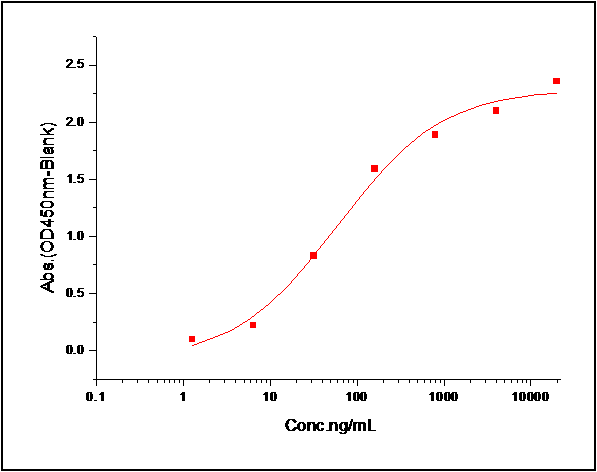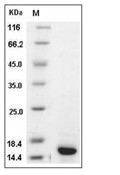购物车
- 全部删除
 您的购物车当前为空
您的购物车当前为空

S100A9 Protein, Human, Recombinant (His) is expressed in Baculovirus insect cells with His tag. The predicted molecular weight is 14.6 kDa and the accession number is P06702.

| 规格 | 价格 | 库存 | 数量 |
|---|---|---|---|
| 100 μg | ¥ 3,820 | 现货 | |
| 200 μg | ¥ 6,750 | 5日内发货 | |
| 500 μg | ¥ 14,280 | 5日内发货 |
| 生物活性 | Measured by its binding ability in a functional ELISA. Immobilized S100A8-His at 10 μg/ml (100 μl/well) can bind S100A9-His , The EC50 of S100A9-His is 0.35-0.70 μg/mL.  |
| 产品描述 | S100A9 Protein, Human, Recombinant (His) is expressed in Baculovirus insect cells with His tag. The predicted molecular weight is 14.6 kDa and the accession number is P06702. |
| 种属 | Human |
| 表达系统 | Baculovirus Insect Cells |
| 标签 | C-His |
| 蛋白编号 | P06702 |
| 别名 | S100 calcium binding protein A9,P14,NIF,MRP-14,MRP14,MIF,MAC387,LIAG,L1AG,CGLB,CFAG,CAGB,60B8AG |
| 蛋白构建 | A DNA sequence encoding the human S100A9 (NP_002956.1) (Met 1-Pro 114) was expressed, fused with a polyhistidine tag at the C-terminus. Predicted N terminal: Met |
| 蛋白纯度 | > 95 % as determined by SDS-PAGE  |
| 分子量 | 14.6 kDa (predicted); 16 kDa (reducing conditions) |
| 内毒素 | < 1.0 EU/μg of the protein as determined by the LAL method. |
| 缓冲液 | Lyophilized from a solution filtered through a 0.22 μm filter, containing PBS, pH 7.4. Typically, a mixture containing 5% to 8% trehalose, mannitol, and 0.01% Tween 80 is incorporated as a protective agent before lyophilization. |
| 复溶方法 | A Certificate of Analysis (CoA) containing reconstitution instructions is included with the products. Please refer to the CoA for detailed information. |
| 存储 | It is recommended to store recombinant proteins at -20°C to -80°C for future use. Lyophilized powders can be stably stored for over 12 months, while liquid products can be stored for 6-12 months at -80°C. For reconstituted protein solutions, the solution can be stored at -20°C to -80°C for at least 3 months. Please avoid multiple freeze-thaw cycles and store products in aliquots. |
| 运输方式 | In general, Lyophilized powders are shipping with blue ice. |
| 研究背景 | S100 protein is a family of low molecular weight protein found in vertebrates characterized by two EF-hand calcium-binding motifs. There are at least 21 different S100 proteins, and the name is derived from the fact that the protein is 100% soluble in ammonium sulfate at neutral pH. Most S100 proteins are disulfide-linked homodimer, and is normally present in cells derived from the neural crest, chondrocytes, macrophages, dendritic cells, etc. S100 proteins have been implicated in a variety of intracellular and extracellular functions. They are involved in regulation of protein phosphorylation, transcription factors, the dynamics of cytoskeleton constituents, enzyme activities, cell growth and differentiation, and the inflammatory response. Protein S100-A9, also known as S100 calciumbinding protein A9, S100A9, and CAGB, is a member of the S-100 family. S100A9 is expressed by macrophages in acutely inflammed tissues and in chronic inflammation. It is also expressed in epithelial cells constitutively or induced during dermatoses. S100A9 is a calcium-binding protein. It has anti-microbial activity towards bacteria and fungi. The anti-microbial and proapoptotic activity of S100A9 is inhibited by zinc ions. S100A9 plays a role in the development of endotoxic shock in response to bacterial lipopolysaccharide (LPS). It promotes tubulin polymerization when unphosphorylated. It also promotes phagocyte migration and infiltration of granulocytes at sites of wounding. S100A9 plays a role as a proinflammatory mediator in acute and chronic inflammation and up-regulates the release of IL8 and cell-surface expression of ICAM1. |